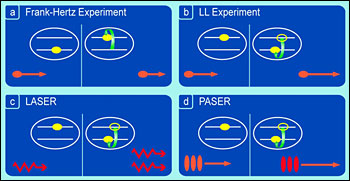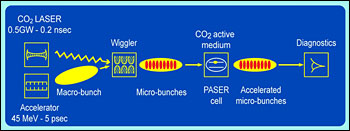
Laser's Particle Analog Demonstrated
UPTON, N.Y., Sept. 13, 2006 -- Particle acceleration by stimulated emission of radiation (PASER), a sort of particle analog of the laser process, has been demonstrated for the first time by a team of physicists, according to the American Institute of Physics (AIP).
In a regular laser, photons traveling through an active medium (a body of excited atoms) will stimulate the atoms, through collisions, to surrender their energy in the form of additional emitted photons; this coherent process builds on itself until a large pulse of intense light exits the cavity in which the amplification takes place.
 |
Top image: Four methods of transferring energy. (a) The Franck-Hertz experiment of 1914, which demonstrated that electrons passing through a vapor of mercury atoms could excite the atoms to higher energies. (b) The Latysheff-Leipunsky experiment of 1930 showing the inverse process: excited atoms could transfer some of their energy to passing electrons. (c) The laser process by which an excited atom can be stimulated to emit some of its energy as a photon in concert with a similar photon already moving through the resonant cavity. (d) The PASER process in which excited atoms transfer energy not into creating photons but into accelerating electrons. (Images courtesy AIP) Bottom image: Experimental PASER setup. Electrons from an accelerator are modulated into short bursts by a co-moving CO2 laser and by the use of a "wiggler" magnet array, through which the electron bursts move. Later the electron microbursts acquire energy from the excited CO2 atoms in a special cavity. |
 |
In the new proof-of-principle PASER experiment, reported in AIP's Physics News Update, the active medium consists of a CO2 vapor, and instead of surrendering their energy in the form of stimulated photons, the atoms transfer their energy to a beam of electrons. The electrons stimulate the atoms into giving up their surplus energy through collisions. The electrons' energy is amplified in a coherent way; that is, the electrons are directly accelerated by a direct and coordinated quantum transfer of energy.
Although millions of collisions are involved for each electron, no heat is generated. The transferred energy goes into an enhanced electron motion. One could say that here was a laser which produced no laser light, only a laser-like transfer of energy resulting in electron acceleration.
It should be said that the electrons began with an energy of 45 million electron volts (MeV) and absorbed only a modest energy of about 200,000 electron volts (keV). The electrons, first accelerated in a conventional accelerator, were also exposed to a CO2 laser and also sent through a "wiggler" array of magnets; these actions served to carve a larger bunch of electrons into separate microbunches, which are timed and modulated in energy in order to more readily partake of the resonant PASER process in the CO2-filled resonant cavity a little farther along.
Being able to accelerate electrons with energy stored in individual atoms/molecules, a concept now demonstrated with the PASER, provides new opportunities since the accelerated electrons may prove to be significantly "cooler" (they are more collimated in velocity) than in some other prospective acceleration schemes, enabling in turn the secondary generation of high-quality x-rays, which are an essential tool in nanoscience.
The work, by physicists from the Technion-Israel Institute of Technology in Haifa, Israel, using the accelerator facilities at the Brookhaven National Lab in Upton, Long Island, be described in an upcoming issue of Physical Review Letters. For more information, visit: www.aip.org
Published: September 2006